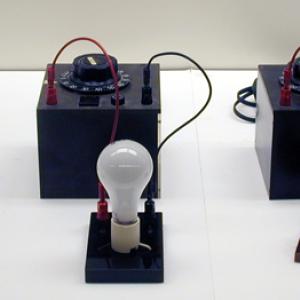College of Liberal Arts & Sciences
8B30.10 - Stellar Magnitude
The 1000 watt, 100 watt, and 1/4 watt bulbs will give some idea of stellar magnitudes.
If the brightness of each bulb scales linearly, the 100 watt bulb will be 400 times brighter than the 1/4 watt bulb, and the 1000 watt bulb will be 4000 time brighter. From that should be able to do a calculation of brightness vs. distance. For instance, if the 1/4 watt bulb is at a fixed distance from the observer, how far away would the 100 or 1000 watt bulbs have to be moved to have the same observed brightness as the 1/4 watt bulb.
- Prof. Thomas Hocket, "Luminosity, Brightness, and Distance", TPT, Vol. 52, # 1, Jan 2014, p. 6.
- E. S. Oberhofer, "Different Magnitude Differences", TPT, Vol. 29, # 5, May 1991, p. 273.
- Christopher Sirola, "I Love My Baffling, Backward, Counterintuitive, Overly Complicated Magnitudes", TPT, Vol. 55, #2, February 2017, p. 124-125.
- Chirstopher Sirola, "Stellar photometry in an introductory physics lab (or, translating flux into magnitudes)", TPT, Vol. 61, #4, Apr. 2023, p. 310.
- Eric Schulman and Caroline V. Cox, "Misconceptions about Astronomical Magnitudes", AJP, Vol. 65, #10, Oct. 1997, p. 1003.
- James A. Blackburn, "Integrated Circuit Stellar Magnitude Simulator", AJP, Vol. 46, #8, Aug. 1978, p. 813.
- Donald C. Warren, "Cosmic Extremes of Luminosity", Physics Today, Vol. 78, #2, Feb. 2025, p. 54.
- Janice VanCleave, "Star Bright", Constellations for Every Kid, p. 141.
Disclaimer: These demonstrations are provided only for illustrative use by persons affiliated with The University of Iowa and only under the direction of a trained instructor or physicist. The University of Iowa is not responsible for demonstrations performed by those using their own equipment or who choose to use this reference material for their own purpose. The demonstrations included here are within the public domain and can be found in materials contained in libraries, bookstores, and through electronic sources. Performing all or any portion of any of these demonstrations, with or without revisions not depicted here entails inherent risks. These risks include, without limitation, bodily injury (and possibly death), including risks to health that may be temporary or permanent and that may exacerbate a pre-existing medical condition; and property loss or damage. Anyone performing any part of these demonstrations, even with revisions, knowingly and voluntarily assumes all risks associated with them.
